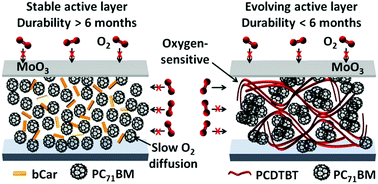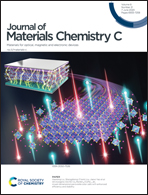Durable organic solar cells produced by in situ encapsulation of an air-sensitive natural organic semiconductor by the fullerene derivative and the metal oxide layer†
Abstract
β-Carotene (bCar) is a natural organic semiconductor that photo-degrades within a few minutes when exposed to sunlight in ambient conditions and that can be employed as electron donor in organic solar cell (OSC) active layers. Its fast photo-degradation kinetics make bCar an ideal molecule to study strategies to improve the durability of OSCs. Mixing bCar with [6,6]-phenyl-C71-butyric acid methyl ester (PC71BM) in a 1 : 4 ratio considerably delays the bCar photo-bleaching to produce thin films that are relatively stable when exposed to sunlight for more than an hour. Furthermore, when coated with OSC top electrodes, these active layers exhibit an even stronger resistance again photo-oxidation. Despite the easily photo-oxidized nature of bCar, the resulting bCar:PC71BM OSCs maintain their photovoltaic performances for over 6 months without additional encapsulation and display high thermal stability. In fact, the binary bCar:PC71BM active layers with a large relative concentration of PC71BM exhibit a longer operational stability than reference air-stable active layers in the organic photovoltaic field, namely, poly(2,7-carbazole-alt-dithienylbenzothiadiazole):PC71BM active layers prepared with the same electron donor to PC71BM ratio (1 : 4). The superior durability of bCar OSCs compared to PCDTBT ones can be ascribed to their higher morphological stability which is associated with lower mixing energies in small molecule:fullerene systems with respect to polymer:fullerene ones. Our results thus indicate that small molecule donors combined with PC71BM into active layers have a high potential to produce OSCs that simultaneously achieve high power conversion efficiencies and durability.



 Please wait while we load your content...
Please wait while we load your content...